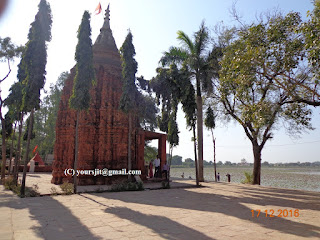Siddheshwar Temple, Palari,
Balodabazar
(A blog by Jitendra Nakka)
Introduction
The
district of Balodabazaar lies in the central part of the Chhattisgarh state and
blessed with some of the most beautiful ancient temples of Chhattisgarh,
depicting the glorious history of area. One such perfect religious place in
Balodabazaar is Palari’s ancient shiv temple also called Siddheshwar Temple.
Figure:Front Side View of Siddheshwar temple, Palari
Figure:Front Side View of Siddheshwar temple, Palari
Figure:Back Side View of Siddheshwar temple, Palari
Where and How to reach?
Palari
town is the block Head Quarter of Palari of Balodabazaar District and situated
nearly 65 km North of State Head-Quarter, Raipur and nearly 15 kms South of
district Head-Quarter, Baloda-Bazaar. Here, the ancient Shiv temple lies 2 kms
East of Palari near the outer of township at the bank of Bal-Samund Pond. This
place is approachable throughout the year as it lies directly on the
Raipur-Balodabazaar State Highway. The Nearest Railway Station and Airport is
Raipur. Nearby Raipur and Balodabazaar, there are many luxurious hotels which
interesting tour packages to tourists.
Figure: Siddheshwar temple
Salient Features:
Salient Features:
Siddheshwar temple lies on the
bank of Balsamund pond, and built in a manner of old brick made construction,
gives it a unique distinction, next to Laxman temple of Sirpur. The experts
have observed ornamentation of different type of Goddess and Goddesses on the
outer wall of temple like Kartik, Ganesh, Gaj-laxmi. On the contrary,
the inner walls of the temple are rather ornamentation-less.
Figure: Brick carved statue of Lord Ganesha on the outer Wall
Figure: Shivling in the Garbh-Griha
Figure: Brick carved statue of Lord Ganesha on the outer Wall
Figure: Shivling in the Garbh-Griha
The
temple seems to have two chambers where the first chambers looks like an open mandap
followed by Garbh-Griha which is the second and the main chamber. The
front of the Garbh-Griha is ornamented by stone carved idols of Goddesses Ganga
and Yamuna while the fore-head or the space above the
Garbh-Griha is occupied by exotic carvation of Marriage Ceremony of Lord Shiva
where thrice of the dev (tridev)
are said to have appeared with each other. Being one of the best examples of
brick-made constructions of Central India, Palari Shiv Temple is believed to
have been built during 7th -8th Century.
Figure: Statue of Ganga and Jamuna in the either side of Entrance Gate of Garbh-Griha
On
the left side of courtyard/campus of the temple, where there is a Pipal tree,
where a recent found idol of Siddh-Baba is placed openly, in
order to exhibit the external excavations. There are few temples nearby which
have been constructed recently.
Figure: Siddh Baba Idol
Figure: Siddh Baba Idol
Conclusion:
This
place is an ideal place for historians to read and obsercve the ancient
brick-made buildings of Central India. I believe this temple has the potential
to drive everybody’s attention, if proper promotion of this place is done.





































































